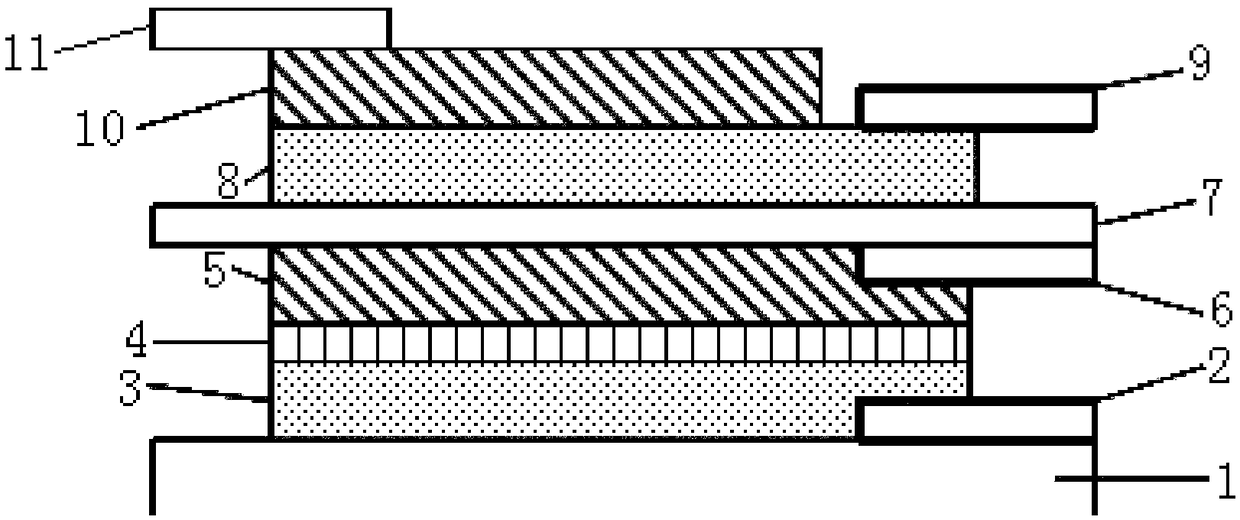A dual-band thin-film photodetector and its preparation method
A photodetector and dual-band technology, which is applied in semiconductor devices, final product manufacturing, sustainable manufacturing/processing, etc., can solve the problems of limited detection band and limited response rate of photodetectors, so as to improve device responsivity, Simple preparation process and good light absorption properties
- Summary
- Abstract
- Description
- Claims
- Application Information
AI Technical Summary
Problems solved by technology
Method used
Image
Examples
Embodiment 1
[0044]1) Select silicon wafer, glass or PET plastic as the base sheet 1, clean it, spin-coat photoresist on its surface, and pass photolithography process, figure 1 The photoresist at the position of the middle electrode is washed away after exposure to form grooves.
[0045] 2) Depositing the first electrode layer 2 on the surface of the sample by electron beam evaporation process, the thickness of which is 10 nm.
[0046] 3) Soak the above sample with acetone to remove the remaining photoresist.
[0047] 4) adopt chemical vapor deposition method to prepare graphene thin film on a copper foil, it can be monolayer or several layers, and transfer to the surface of the first electrode layer 2 of step (2) gained; Wherein the transfer method of graphene thin film For: uniformly coating a layer of polymethyl methacrylate film on the surface of the graphene film, then putting it into an etching solution for 4 hours to etch and remove the copper foil, leaving a graphene film support...
Embodiment 2
[0063] 1) Select silicon wafer, glass or PET plastic as the base sheet 1, clean it, spin-coat photoresist on its surface, and pass photolithography process, figure 1 The photoresist at the position of the middle electrode is washed away after exposure to form grooves.
[0064] 2) Depositing the first electrode layer 2 on the surface of the sample by electron beam evaporation process, the thickness of which is 100 nm.
[0065] 3) Soak the above sample with acetone to remove the remaining photoresist.
[0066] 4) adopt chemical vapor deposition method to prepare graphene thin film on a copper foil, it can be monolayer or several layers, and transfer to the surface of the first electrode layer 2 of step (2) gained; Wherein the transfer method of graphene thin film For: the surface of the graphene film is uniformly coated with a layer of polymethyl methacrylate film, then put into an etching solution for 5h to etch and remove the copper foil, leaving a graphene film supported by ...
Embodiment 3
[0082] 1) Select silicon wafer, glass or PET plastic as the base sheet 1, clean it, spin-coat photoresist on its surface, and pass photolithography process, figure 1 The photoresist at the position of the middle electrode is washed away after exposure to form grooves.
[0083] 2) Depositing the first electrode layer 2 on the surface of the sample by electron beam evaporation process, the thickness of which is 200nm.
[0084] 3) Soak the above sample with acetone to remove the remaining photoresist.
[0085] 4) adopt chemical vapor deposition method to prepare graphene thin film on a copper foil, it can be monolayer or several layers, and transfer to the surface of the first electrode layer 2 of step (2) gained; Wherein the transfer method of graphene thin film For: the surface of the graphene film is uniformly coated with a layer of polymethyl methacrylate film, and then put into an etching solution for 4.5h to remove the copper foil by corrosion, leaving a graphene film supp...
PUM
 Login to View More
Login to View More Abstract
Description
Claims
Application Information
 Login to View More
Login to View More - R&D
- Intellectual Property
- Life Sciences
- Materials
- Tech Scout
- Unparalleled Data Quality
- Higher Quality Content
- 60% Fewer Hallucinations
Browse by: Latest US Patents, China's latest patents, Technical Efficacy Thesaurus, Application Domain, Technology Topic, Popular Technical Reports.
© 2025 PatSnap. All rights reserved.Legal|Privacy policy|Modern Slavery Act Transparency Statement|Sitemap|About US| Contact US: help@patsnap.com

